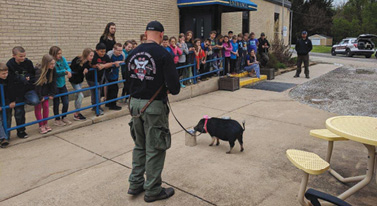February 2020 • Volume 108 • Number 2 • Page 10
Thank you for viewing this Illinois Bar Journal article. Please join the ISBA to access all of our IBJ articles and archives.
LawPulse
Cannabis Sniffing Dogs Staying Around
An Illinois K-9 trainer, skilled enough to also train a drug-sniffing pig, discusses the world of detection dogs.

It started out as a joke: Sangamon County Deputy Sheriff Drew Dickason had long wanted a pet pig, so a year ago, he found himself taking home Ellie Mae, a black and white pot-belly that now weighs about 40 pounds.
“I always wanted one. They’re very intelligent,” Dickason says. “I got her home and taught her to sit, lie down, spin, and hop up. My buddies said it would be hilarious if she could sniff out drugs. I said, ‘I bet I can train her to.” They said, ‘No way.’” To make a long story short: Dickason, who is the Sangamon County Sheriff Office’s lead K-9 officer, now takes Ellie Mae along with his dogs to school and public demonstrations, where she and her canine peers sniff out hidden contraband. “It’s getting to the point that people are now calling for the pig and not the dogs,” he says.
Drug-sniffing pigs are not new. Attempts have been made to use them in law enforcement throughout the world, including in Illinois. But pigs are an impractical choice for a number of reasons, Dickason says. Ellie Mae can sprint for a few paces alongside the Dutch Shepherds and Belgian Malinois he trains, but she tires easily (the Malinois is becoming a favorite breed for detection and patrol, over the Shepherds, Dickason says, because of its high energy and agility—Shepherds are good workers, but tend to move more slowly and meticulously). Ellie Mae also isn’t agile enough to navigate areas dogs are expected to search.
Dickason says there’s no real comparison between Ellie Mae and the puppies he trains three times a day and that are expected to pass the rigorous Illinois State Police’s Drug Detection Canine Compliance Program, which was updated in 2019 and requires dogs to detect various odors inside 20 strategically placed PVC tubes. Some of the odors are “distraction” scents, such as hot dogs. Cannabis also now can be among the distraction scents a dog is trained to ignore.
Still useful, but phasing out
News leading up to the legalization of cannabis quoted many in the K-9 community who warned that the new law would leave law enforcement agencies with a bunch of useless dogs. But Dickason and others say this hasn’t happened.
“Cannabis is still illegal to possess in commercial motor vehicles, school property, and jails, so cannabis-imprinted canines will continue in service to the citizens of Illinois,” says Sergeant Christopher Watson from the Illinois State Police’s (ISP) Public Information Office. “The ISP canine unit is not selling, loaning, or giving [away] any of its cannabis canines.”
The ISP currently has 54 canine teams, 51 of which can detect narcotics. Among the 51, 12 are noncannabis-imprinted dogs. But last spring, the ISP stopped training dogs to imprint on cannabis, in anticipation of the legalization of recreational cannabis. The cannabis-imprinted dogs will gradually be replaced as they naturally retire, Watson says. Dickason, who trains detection dogs for other law-enforcement agencies on the side, also no longer trains dogs to follow the scent of cannabis.
As for dogs in the ISP canine unit that have been trained to detect cannabis, they will continue working and will be replaced by natural attrition with noncannabis-alerting canines. Dickason says that canines are rarely one-scent trackers; for example, his cannabis-imprinted dogs are dually trained to track people or retrieve articles such as guns and can also detect cocaine, methamphetamine, and heroin. In other words, Dickason says there’s plenty for these dogs to do.
Canine controversies
The use of detection dogs continues to factor prominently in caselaw. Before the February issue of the Illinois Bar Journal went to press, the Illinois Supreme Court was considering People v. Jonathan Lindsey, a case it heard in late 2019, regarding the constitutionality of a search initiated after a K-9 picked up the scent of heroin from the hallway outside the defendant’s motel room.
Questionable tactics can also be used on the training side. For example, Dickason is leery of anyone claiming that a cannabis-imprinted dog can be retrained to no longer alert to the substance. “Some say you can, but I haven’t seen it happen. It would require a pretty physical approach—lots of negative reinforcement,” says Dickason, who relies on positive reinforcement and incentives in his training.
Negative (i.e., punishment-based) training techniques can also lead to more false alerts as the dogs are anxious to avoid pain. “Back in the day, there were lots of instances of compulsion among dogs from negative discipline,” Dickason says.
While Dickason is not offering his expertise to defense attorneys, he did recall the one time he had to defend a dog in court. He said what helped the most were the detailed training logs he kept that documented his methods and the dog’s proficiency and consistency. He used the same techniques with Ellie Mae, who recently learned how to open up the cabinets in Dickason’s home and feasted on a bunch of apples, protein shakes, septic tank cleaner, and two light bulbs—something K-9s aren’t likely ever to do.
Pete Sherman is Managing Editor of the Illinois Bar Journal.

